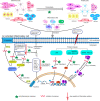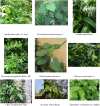Anti-Inflammatory Medicinal Plants of Bangladesh-A Pharmacological Evaluation
- PMID: 35401207
- PMCID: PMC8987533
- DOI: 10.3389/fphar.2022.809324
Anti-Inflammatory Medicinal Plants of Bangladesh-A Pharmacological Evaluation
Abstract
Inflammatory diseases are considered major threats to human health worldwide. In Bangladesh, a number of medicinal plants have been used in traditional medicine from time immemorial in the treatment of diverse diseases, including inflammatory disorders. This assignment aims at providing the status of the medicinal plants of Bangladesh which are traditionally used in the management of inflammatory disorders and are investigated for their anti-inflammatory prospects using different preclinical studies and future research directions. The information of medicinal plants assembled in this review was obtained from a literature search of electronic databases such as Google Scholar, PubMed, Scopus, Web of Science and ScienceDirect up to December, 2020 from publications on plants investigated for their anti-inflammatory activities, in which the place of plant sample collection was identified as Bangladesh. Keywords for primary searches were "anti-inflammatory," "Bangladeshi," and "medicinal plants." Criteria followed to include plant species were plants that showed significant anti-inflammatory activities in 1) two or more sets of experiments in a single report, 2) same or different sets of experiments in two or more reports, and, 3) plants which are traditionally used in the treatment of inflammation and inflammatory disorders. In this study, 48 species of medicinal plants have been reviewed which have been used in traditional healing practices to manage inflammatory disorders in Bangladesh. The mechanistic pathways of the in vivo and in vitro study models used for the evaluation of anti-inflammatory properties of plant samples have been discussed. Selected plants were described in further detail for their habitat, anti-inflammatory studies conducted in countries other than Bangladesh, and anti-inflammatory active constituents isolated from these plants if any. Medicinal plants of Bangladesh have immense significance for anti-inflammatory activity and have potential to contribute toward the discovery and development of novel therapeutic approaches to combat diseases associated with inflammation. However, the plants reviewed in this article had chiefly undergone preliminary screening and require substantial investigations including identification of active molecules, understanding the mechanism of action, and evaluation for safety and efficacy to be followed by the formulation of safe and effective drug products.
Keywords: Bangladeshi; inflammation; medicinal plants; preclinical study; traditional.
Copyright © 2022 Akhtar.
Conflict of interest statement
The author declares that the research was conducted in the absence of any commercial or financial relationships that could be construed as a potential conflict of interest.
Figures








Similar articles
-
Medicinal plants used against hepatic disorders in Bangladesh: A comprehensive review.J Ethnopharmacol. 2022 Jan 10;282:114588. doi: 10.1016/j.jep.2021.114588. Epub 2021 Sep 1. J Ethnopharmacol. 2022. PMID: 34480997 Review.
-
Medicinal plants from the genus Acalypha (Euphorbiaceae)--a review of their ethnopharmacology and phytochemistry.J Ethnopharmacol. 2015 Jan 15;159:137-57. doi: 10.1016/j.jep.2014.10.040. Epub 2014 Oct 30. J Ethnopharmacol. 2015. PMID: 25446604 Review.
-
The genus Inula and their metabolites: from ethnopharmacological to medicinal uses.J Ethnopharmacol. 2014 Jun 11;154(2):286-310. doi: 10.1016/j.jep.2014.04.010. Epub 2014 Apr 19. J Ethnopharmacol. 2014. PMID: 24754913
-
A review of five traditionally used anti-diabetic plants of Bangladesh and their pharmacological activities.Asian Pac J Trop Med. 2017 Oct;10(10):933-939. doi: 10.1016/j.apjtm.2017.09.002. Epub 2017 Sep 18. Asian Pac J Trop Med. 2017. PMID: 29111187 Review.
-
Genus Paeonia: A comprehensive review on traditional uses, phytochemistry, pharmacological activities, clinical application, and toxicology.J Ethnopharmacol. 2021 Apr 6;269:113708. doi: 10.1016/j.jep.2020.113708. Epub 2020 Dec 24. J Ethnopharmacol. 2021. PMID: 33346027 Review.
Cited by
-
Scutellaria petiolata Hemsl. ex Lace & Prain (Lamiaceae).: A New Insight in Biomedical Therapies.Antioxidants (Basel). 2022 Jul 26;11(8):1446. doi: 10.3390/antiox11081446. Antioxidants (Basel). 2022. PMID: 35892648 Free PMC article.
-
Editorial: Medicinal plants as a source of novel autoimmune-modulating and anti-inflammatory drug products.Front Pharmacol. 2022 Sep 6;13:978581. doi: 10.3389/fphar.2022.978581. eCollection 2022. Front Pharmacol. 2022. PMID: 36147323 Free PMC article. No abstract available.
-
In-vitro Antioxidant and In-vivo Analgesics and Anti-inflammatory Activity of Allamanda blanchetii Leaf Extract in Rats.Antiinflamm Antiallergy Agents Med Chem. 2025;24(2):114-126. doi: 10.2174/0118715230340178241008163943. Antiinflamm Antiallergy Agents Med Chem. 2025. PMID: 39681830
References
-
- Adegbite A. E., Sanyaolu E. B. (2009). Cytotoxicity Testing of Aqueous Extract of Bitter Leaf (Vernonia Amygdalina Del.) Using the Allium cepa Chromosome Aberration Assay. Scientific Res. Essays 4 (11), 311–1314. 10.5897/SRE.9000315 - DOI
-
- Ahmad Khan M. S., Ahmad I. (2019). “Herbal Medicine,” in New Look to Phytomedicine. Editors Ahmad Khan M. S., Ahmad I., Chattopadhyay D. (Academic Press; ), 3–13. 10.1016/b978-0-12-814619-4.00001-x - DOI
-
- Ahmed F., Shahid I. Z., Biswas U. K., Roy B. A., Das A. K., Choudhuri M. S. K. (2007). Anti-inflammatory, Antinociceptive, and Neuropharmacological Activities ofClerodendron Viscosum. Pharm. Biol. 45 (7), 587–593. 10.1080/13880200701501342 - DOI
-
- Ahmed R., Choudhury S., Vajczikova I., Leclercq P. A. (2000). Essential Oils ofGlycosmis pentaphylla(Cor.). A New Report from Assam, India. J. Essent. Oil Res. 12 (4), 471–474. 10.1080/10412905.2000.9699568 - DOI
-
- Akber M., Seraj S., Nahar N., Islam F., Ahsan S., Ferdausi D., et al. (2011). A Survey of Medicinal Plants Used by the Traditional Medicinal Practitioners of Khulna City, Bangladesh. American-Eurasian J. Sustainable Agric. 5 (2), 177–195.
Publication types
LinkOut - more resources
Full Text Sources

